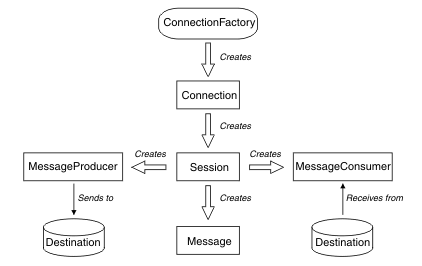The XMS object model
The XMS API is an object-oriented interface. The XMS object model is based on the JMS 1.1 object model.
- ConnectionFactory
- A ConnectionFactory object encapsulates a set of parameters for a connection. An application uses a ConnectionFactory to create a connection. An application can provide the parameters at run time and create a ConnectionFactory object. Alternatively, the connection parameters can be stored in a repository of administered objects. An application can retrieve an object from the repository and create a ConnectionFactory object from it.
- Connection
- A Connection object encapsulates an active connection from an application to a messaging server. An application uses a connection to create sessions.
- Destination
- An application sends messages or receives messages using a Destination object. In the publish/subscribe domain, a Destination object encapsulates a topic and, in the point-to-point domain, a Destination object encapsulates a queue. An application can provide the parameters to create a Destination object at run time. Alternatively, it can create a Destination object from an object definition that is stored in repository of administered objects.
- Session
- A Session object is a single threaded context for sending and receiving messages. An application uses a Session object to create Message, MessageProducer, and MessageConsumer objects.
- Message
- A Message object encapsulates the Message object that an application sends using a MessageProducer object, or receives using a MessageConsumer object.
- MessageProducer
- A MessageProducer object is used by an application to send messages to a destination.
- MessageConsumer
- An MessageConsumer object is used by an application to receive messages sent to a destination.
Figure 1 shows these objects and their relationships. This diagram shows the main types of XMS object: ConnectionFactory, Connection, Session, MessageProducer, MessageConsumer, Message, and Destination. An application uses a connection factory to create a connection, and uses a connection to create sessions. The application can then use a session to create messages, message producers, and message consumers. The application uses a message producer to send messages to a destination, and uses a message consumer to receive messages sent to a destination.

In .NET, the XMS classes are defined as a set of .NET interfaces. When you are coding XMS .NET applications, you need only the declared interfaces.
The XMS object model is based on the domain independent interfaces that are described in Java Message Service Specification, Version 1.1. Domain-specific classes, such as Topic, TopicPublisher, and TopicSubscriber, are not provided.